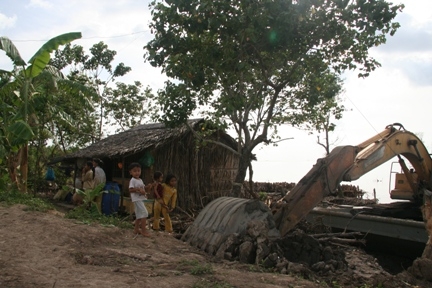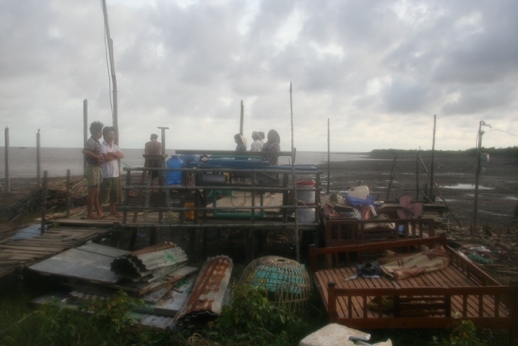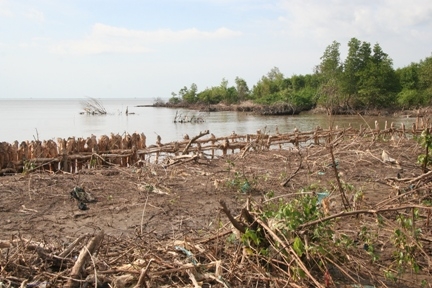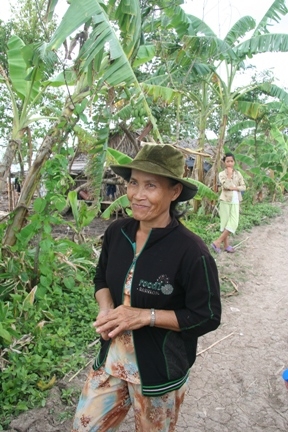People living along the Mekong Delta may not have ever heard about climate change, but they live with its consequences everyday.

A man made dike is being enforced by mud to resist the havoc of climate change
Huynh Ngoc Kieu has never heard about climate change. But she lives with its consequences.
As we stop by at her house, the 33 year old woman is hard at work pulling nails out of her old floor boards; taking the house apart to move it away from the coastline - and away from the frontline of climate change.
Situated on the edge of land in the Mekong Delta’s southernmost Ca Mau Province, where one of the many outflows of the vast Mekong River runs into the sea right on the border with Bac Lieu Province, it was barely four months ago since the family last moved their house away from the coastline.

Huynh Ngoc Kieu has never heard of climate change, but taking the family's house apart for the second time in four months to move it out of reach of the waves, she has felt the consequences of rising sea levels.
The tide has pulled masses of water out for now, but during a recent storm the floor boards were flooded with 50 centimetres of sea-water for days, and local authorities have instructed the family to move to safer grounds.
“We have more storms than usual," said one of the neighbours who had come to lend a hand.
“And the storms wreak more havoc than they used to do," agreed Huynh Ngoc Kieu.
Debris in the water are evidence of former settlement's on the river bank. Last year 48 families moved to drier ground; so far this year 52 families have followed suit.
No one has ever bothered to tell Huynh Ngoc Kieu about global climate change and its consequences, and no one has ever shown her the statistical evidence of more extreme weather and a 20 centimetres raise of the sea level during the previous half of a century. Instead she blames the fancy dyke, which has in recent years been built on the Bac Lieu side of the river mouth, for sending the immense and devastating waves her way. And for stealing her livelihood.
From her house on the edge, Huynh Ngoc Kieu used to sell petrol and other basic items such as cigarettes, instant noodles and fish sauce; now that the authorities have directed the family to higher grounds 300 metres further away from the coastline, she has no idea how she will make in income in the future.
We arrived by motorboat alongside the World Wildlife Foundation (WWF) to witness firsthand the effects of global climate.
The massive Mekong River is habitat for more than 1.300 species of fish, and provides food and livelihood for at least 60 million people according to WWF.
The 65,000 square kilometre Mekong River basin boasts a uniquely rich biodiversity. In addition, it accounts for 90 percent of Vietnam’s rice export and contributes to 27 percent of the country’s GDP. It is also home to some 17 million people.
The Mekong Delta has also become one of the single most exposed areas to climate change in the world. According to recent international research, the sea level will have risen 1.4 metres by 2100 leaving the Mekong Delta under water and turning millions of people into climate refugees, while the consequences for nature will be irreversible.
Even taking the Vietnamese government’s less gloomy figures into consideration, 38 percent or 15.000 square kilometres of the delta and one quarter of Ho Chi Minh City will have disappeared by the turn of the century.
In a report published by the Vietnam Institute of Meteorology, Hydrology and Environment, ahead of the current Copenhagen summit on climate change, experts also predict significant changes to the pattern of rain and temperature. Allowing for considerable regional and seasonal fluctuations in the coming 90 years. The rise in temperature and unpredictable rain will cause severe flooding as well as extreme drought, according to the report.
Climate change is not just a dire prediction of the future, it is here and already affecting the lives of thousands right here in Vietnam.
The Mekong Delta has always been vulnerable to natural disasters. Cyclones and lightning have in the past destroyed houses, killed people and eroded banks while heavy rains have caused inundation, destroyed agriculture and brought outbreaks of waterborne diseases..
The margin of safety for its 1.2 million inhabitants is thin – all of this 5.329 square kilometre province is according to the WWF, on average only one meter above sea level.
Poverty rates in Ca Mau Province are at 30-40 percent according to September 2007 government figures. On top of that, poor rice farmers have increasingly seen their paddy fields destroyed by salt water intrusion, killing an otherwise healthy paddy within a few days.
The province has for years been protected by a dike and a buffer zone of mangrove forest which originally expanded one kilometre from the coastline. But the dikes have been undermined by nature’s force and a lack of maintenance. In many places local shrimp farmers dig through dikes to lead salt water into their ponds has also taken a toll. The coastline has been altered by erosion since vast areas of mangrove forest, which used to cover the low lying delta offering a natural coastal barrier, have disappeared. Cut down to provide space for shrimp farming, and - insists Nguyen Thang Nhan, deputy director of the Department of Agriculture and Rural Development in Ca Mau Province, - by natural causes:
“The coastline has never been static, but since 2000 the loss of mangrove has intensified, and the erosion of the costal area on the East coast has been severe. 20-100 meters of mangrove have been swept away every year. We have seen some encroachment by ‘poachers’ but the primary explanation for mangrove loss is storms caused by climate change.”

Sketchy patches of mangrove and a man made dike
To protect the Mekong Delta from intruding salt water, local authorities this month decided to upgrade and repair 1.359 kilometres of coastal dyke.
The decision has been anticipated for a long time, and for some it comes too late.
Nguyen Thi Phuong (not her real name) points to a collection of white washed poles among stubs of broken mangrove trees down the coast and about one hundred metres into what is now the sea. This used to be her home. Fleeing the storms and the havoc of the waves, the family has moved to higher grounds, on state owned land. Nguyen Thi Phuong sighs when asked if they are able to stay there, explaining,“What else can we do? The sea has taken all our family land, and we do not have any money to buy new land. If we keep our heads down, maybe they will let us stay here.”

Nguyen Thi Phuong (not her real name) in front of her house on the very edge of the sea. It is only a matter of time, before the family has to move to safer grounds.
Should the local authorities choose to look the other way, the family home is still far from secured.
Placed on the edge of what now constitutes the coast line among scattered patches of insubstantial mangrove and a man-made dyke consisting merely of poles, mud and twigs, the family is very much at risk of being pushed out of their home from only one storm.
